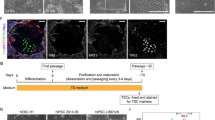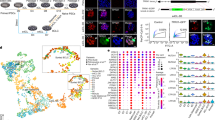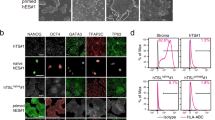Abstract
Embryonic stem (ES) cells are derived from blastocyst-stage embryos and are thought to be functionally equivalent to the inner cell mass, which lacks the ability to produce all extraembryonic tissues. Here we identify a rare transient cell population within mouse ES and induced pluripotent stem (iPS) cell cultures that expresses high levels of transcripts found in two-cell (2C) embryos in which the blastomeres are totipotent. We genetically tagged these 2C-like ES cells and show that they lack the inner cell mass pluripotency proteins Oct4 (also known as Pou5f1), Sox2 and Nanog, and have acquired the ability to contribute to both embryonic and extraembryonic tissues. We show that nearly all ES cells cycle in and out of this privileged state, which is partially controlled by histone-modifying enzymes. Transcriptome sequencing and bioinformatic analyses showed that many 2C transcripts are initiated from long terminal repeats derived from endogenous retroviruses, suggesting this foreign sequence has helped to drive cell-fate regulation in placental mammals.
This is a preview of subscription content, access via your institution
Access options
Subscribe to this journal
Receive 51 print issues and online access
$199.00 per year
only $3.90 per issue
Buy this article
- Purchase on Springer Link
- Instant access to full article PDF
Prices may be subject to local taxes which are calculated during checkout





Similar content being viewed by others
References
Tarkowski, A. K. Experiments on the development of isolated blastomers of mouse eggs. Nature 184, 1286–1287 (1959)
Papaioannou, V. E., Mkandawire, J. & Biggers, J. D. Development and phenotypic variability of genetically identical half mouse embryos. Development 106, 817–827 (1989)
Cockburn, K. & Rossant, J. Making the blastocyst: lessons from the mouse. J. Clin. Invest. 120, 995–1003 (2010)
Latham, K. E. & Schultz, R. M. Embryonic genome activation. Front. Biosci. 6, d748–d759 (2001)
Schultz, R. M. The molecular foundations of the maternal to zygotic transition in the preimplantation embryo. Hum. Reprod. Update 8, 323–331 (2002)
Kan?ka, J. Gene expression and chromatin structure in the pre-implantation embryo. Theriogenology 59, 3–19 (2003)
Evans, M. J. & Kaufman, M. H. Establishment in culture of pluripotential cells from mouse embryos. Nature 292, 154–156 (1981)
Martin, G. R. Isolation of a pluripotent cell line from early mouse embryos cultured in medium conditioned by teratocarcinoma stem cells. Proc. Natl Acad. Sci. USA 78, 7634–7638 (1981)
Beddington, R. S. & Robertson, E. J. An assessment of the developmental potential of embryonic stem cells in the midgestation mouse embryo. Development 105, 733–737 (1989)
Niakan, K. K. et al. Sox17 promotes differentiation in mouse embryonic stem cells by directly regulating extraembryonic gene expression and indirectly antagonizing self-renewal. Genes Dev. 24, 312–326 (2010)
Hayashi, K., Lopes, S. M., Tang, F. & Surani, M. A. Dynamic equilibrium and heterogeneity of mouse pluripotent stem cells with distinct functional and epigenetic states. Cell Stem Cell 3, 391–401 (2008)
Singh, A. M., Hamazaki, T., Hankowski, K. E. & Terada, N. A heterogeneous expression pattern for Nanog in embryonic stem cells. Stem Cells 25, 2534–2542 (2007)
Chambers, I. et al. Nanog safeguards pluripotency and mediates germline development. Nature 450, 1230–1234 (2007)
Zalzman, M. et al. Zscan4 regulates telomere elongation and genomic stability in ES cells. Nature 464, 858–863 (2010)
Peaston, A. E. et al. Retrotransposons regulate host genes in mouse oocytes and preimplantation embryos. Dev. Cell 7, 597–606 (2004)
Evsikov, A. V. et al. Systems biology of the 2-cell mouse embryo. Cytogenet. Genome Res. 105, 240–250 (2004)
Kigami, D., Minami, N., Takayama, H. & Imai, H. MuERV-L is one of the earliest transcribed genes in mouse one-cell embryos. Biol. Reprod. 68, 651–654 (2003)
Svoboda, P. et al. RNAi and expression of retrotransposons MuERV-L and IAP in preimplantation mouse embryos. Dev. Biol. 269, 276–285 (2004)
Ribet, D. et al. Murine endogenous retrovirus MuERV-L is the progenitor of the “orphan” epsilon viruslike particles of the early mouse embryo. J. Virol. 82, 1622–1625 (2008)
Soudais, C. et al. Targeted mutagenesis of the transcription factor GATA-4 gene in mouse embryonic stem cells disrupts visceral endoderm differentiation in vitro . Development 121, 3877–3888 (1995)
Yagi, R. et al. Transcription factor TEAD4 specifies the trophectoderm lineage at the beginning of mammalian development. Development 134, 3827–3836 (2007)
Nishioka, N. et al. Tead4 is required for specification of trophectoderm in pre-implantation mouse embryos. Mech. Dev. 125, 270–283 (2008)
Choo, K. B., Chen, H. H., Cheng, W. T., Chang, H. S. & Wang, M. In silico mining of EST databases for novel pre-implantation embryo-specific zinc finger protein genes. Mol. Reprod. Dev. 59, 249–255 (2001)
Huang, C. J., Chen, C. Y., Chen, H. H., Tsai, S. F. & Choo, K. B. TDPOZ, a family of bipartite animal and plant proteins that contain the TRAF (TD) and POZ/BTB domains. Gene 324, 117–127 (2004)
Zhang, W. et al. Zfp206 regulates ES cell gene expression and differentiation. Nucleic Acids Res. 34, 4780–4790 (2006)
Ying, Q. L. et al. The ground state of embryonic stem cell self-renewal. Nature 453, 519–523 (2008)
Ma, J., Svoboda, P., Schultz, R. M. & Stein, P. Regulation of zygotic gene activation in the preimplantation mouse embryo: global activation and repression of gene expression. Biol. Reprod. 64, 1713–1721 (2001)
Wiekowski, M., Miranda, M., Nothias, J. Y. & DePamphilis, M. L. Changes in histone synthesis and modification at the beginning of mouse development correlate with the establishment of chromatin mediated repression of transcription. J. Cell Sci. 110, 1147–1158 (1997)
Macfarlan, T. S. et al. Endogenous retroviruses and neighboring genes are coordinately repressed by LSD1/KDM1A. Genes Dev. 25, 594–607 (2011)
Rowe, H. M. et al. KAP1 controls endogenous retroviruses in embryonic stem cells. Nature 463, 237–240 (2010)
Yokochi, T. et al. G9a selectively represses a class of late-replicating genes at the nuclear periphery. Proc. Natl Acad. Sci. USA 106, 19363–19368 (2009)
Suzuki, T., Minami, N., Kono, T. & Imai, H. Zygotically activated genes are suppressed in mouse nuclear transferred embryos. Cloning Stem Cells 8, 295–304 (2006)
Shao, G. B. et al. Effect of trychostatin A treatment on gene expression in cloned mouse embryos. Theriogenology 71, 1245–1252 (2009)
Li, W. et al. Generation of human-induced pluripotent stem cells in the absence of exogenous Sox2. Stem Cells 27, 2992–3000 (2009)
Hirata, T. et al. Zscan4 transiently reactivates early embryonic genes during the generation of induced pluripotent stem cells. Sci. Rep. 2, 208 (2012)
Feschotte, C. Transposable elements and the evolution of regulatory networks. Nature Rev. Genet. 9, 397–405 (2008)
Kunarso, G. et al. Transposable elements have rewired the core regulatory network of human embryonic stem cells. Nature Genet. 42, 631–634 (2010)
Lynch, V. J., Leclerc, R. D., May, G. & Wagner, G. P. Transposon-mediated rewiring of gene regulatory networks contributed to the evolution of pregnancy in mammals. Nature Genet. 43, 1154–1159 (2011)
Dupressoir, A. et al. Syncytin-A knockout mice demonstrate the critical role in placentation of a fusogenic, endogenous retrovirus-derived, envelope gene. Proc. Natl Acad. Sci. USA 106, 12127–12132 (2009)
Bénit, L., Lallemand, J. B., Casella, J. F., Philippe, H. & Heidmann, T. ERV-L elements: a family of endogenous retrovirus-like elements active throughout the evolution of mammals. J. Virol. 73, 3301–3308 (1999)
Anders, S. & Huber, W. Differential expression analysis for sequence count data. Genome Biol. 11, R106 (2010)
Huang da, W., Sherman, B. T. & Lempicki, R. A. Systematic and integrative analysis of large gene lists using DAVID bioinformatics resources. Nature Protocols 4, 44–57 (2009)
Acknowledgements
We would like to thank members of the Pfaff laboratory for discussion; S. Andrews, D. Chambers, Y. Dayn, T.-C. Sung, J. Fitzpatrick, M. Joens, Y. Sigal, D. Gibbs and L. Ouyang for technical assistance, Y. Shinkai and D. Gilbert for the G9a mutant ES cells, and T. Heidmann for MuERV-L-Gag antibodies. This research was supported by the National Institute of Neurological Disorders and Stroke (R37NS037116) and the Marshall Heritage Foundation. T.S.M. and W.D.G. were supported by the California Institute for Regenerative Medicine and S.L.P. is an investigator of the Howard Hughes Medical Institute and Benjamin H. Lewis Chair in Neurobiology.
Author information
Authors and Affiliations
Contributions
T.S.M. designed and performed all experiments with assistance from W.D.G., S.D., D.B. and K.L. under the supervision of S.L.P. D.T. generated Kap1 mutant ES cells and H.M.R. and D.T. provided mRNA-seq data from these cells. A.F. and O.S. generated and provided iPS cell lines and lentivirus constructs. T.S.M., W.D.G. and S.L.P. wrote the manuscript.
Corresponding author
Ethics declarations
Competing interests
The authors declare no competing financial interests.
Supplementary information
Supplementary Information
This file contains Supplementary Figures 1-11 and legends for Supplementary Movies 1-3. (PDF 4173 kb)
Supplementary Tables
This zipped file contains Supplementary Tables 1-7. (ZIP 1714 kb)
Supplementary Movie 1
The 2C::tomato reporter is restricted to the zygote and 2C/4C stage - see Supplementary Information fie for full legend. (MOV 543 kb)
Supplementary Movie 2
2C::tomato is transiently expressed in ES cultures - see Supplementary Information fie for full legend. (MOV 2199 kb)
Supplementary Movie 3
Entrance into the 2C::tomato (+) state is more rapid in Kdm1a mutant ES cells - see Supplementary Information fie for full legend. (MOV 2201 kb)
Rights and permissions
About this article
Cite this article
Macfarlan, T., Gifford, W., Driscoll, S. et al. Embryonic stem cell potency fluctuates with endogenous retrovirus activity. Nature 487, 57–63 (2012). https://doi.org/10.1038/nature11244
Received:
Accepted:
Published:
Issue Date:
DOI: https://doi.org/10.1038/nature11244
This article is cited by
-
Ribosomal profiling of human endogenous retroviruses in healthy tissues
BMC Genomics (2024)
-
Quiescence enables unrestricted cell fate in naive embryonic stem cells
Nature Communications (2024)
-
Exit from totipotency is controlled by DUXBL in mice
Nature Genetics (2024)
-
The rules of the totipotency treasure hunt
Nature Cell Biology (2024)
-
The homeobox transcription factor DUXBL controls exit from totipotency
Nature Genetics (2024)
Comments
By submitting a comment you agree to abide by our Terms and Community Guidelines. If you find something abusive or that does not comply with our terms or guidelines please flag it as inappropriate.



